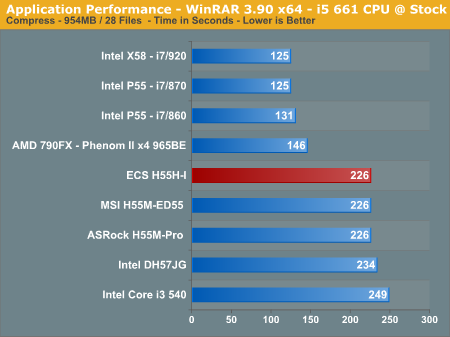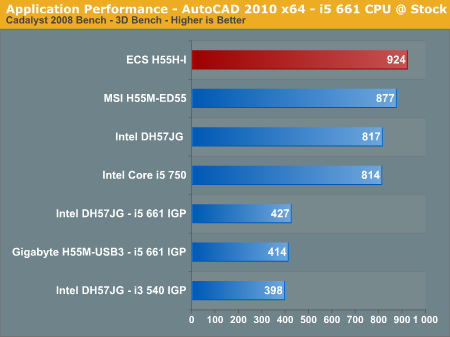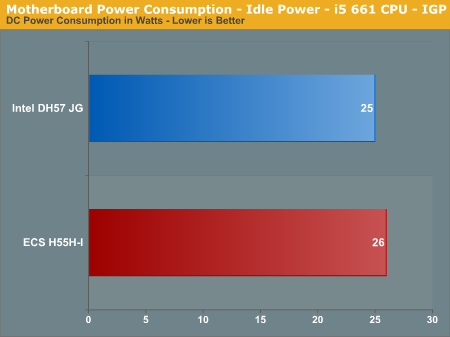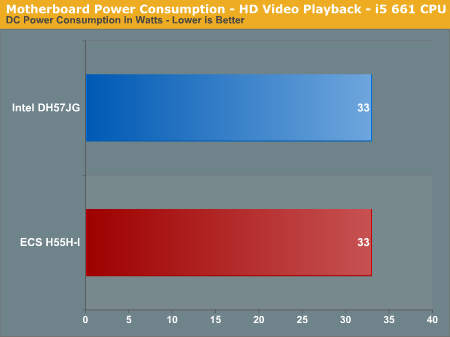ECS H55H-I Review: Mini-ITX at a Sensible Price
by Rajinder Gill on May 6, 2010 6:59 AM EST- Posted in
- Motherboards
Let’s start off with the basic compares:



The H55H-I performs admirably in our benchmark suite, placing mid to top tier in every benchmark we threw at it.
Power Consumption
Our power consumption testing utilizes the same batch of components under similar circumstances in a bid to monitor variances between idle and CPU load conditions. We install the vendor supplied power saving utilities on each board (when available) and enable power saving modes that don't involve any kind of underclocking or CPU core frequency modulation in order to run an apples to apples comparison.
ATX PSU switching losses are absent from our figures because we monitor power consumption directly at the DC rails of the PSU. These figures measure only the CPU, motherboard and memory DC power draw and exclude any other peripherals, such as cooling fans and hard drives etc. AC power consumption at the wall will be anywhere from 15~40% higher than these figures depending upon the efficiency of your power supply.


The DC power consumption figures are almost identical to Intel's DH57JG in every day usage.
Overclocking
The inclusion of over-voltage options for CPU VCore, VTT and VDIMM open the door to a reasonable level of overclocking with Clarkdale processors:

4GHz is attainable on the H55H-I, surpassing the Intel DH57JG.
We added a 0.1V voltage boost to CPU VCore (ignore the 2.20V shown in the CPU-Z screenshot, it's around 1.23V), VTT and VDIMM for the above screenshot and proceeded to pass two hours of Linpack without a glitch. The BIOS does allow you to push higher if you want to, although we think it’s probably safe to stick at a 4GHz limit given the perceived abilities of ECS’ VRM (3 Phase for VCC using 30 amp FETs, giving a theoretical 90 amp maximum under a best case scenario). Bear in mind that if running with the IGP active, you’ll be limited somewhere around 165BCLK anyway, because there is no way to change the IGP clock ratio in BIOS or increase voltage to the graphics core.
For those of you wondering about Lynnfield overclocking, do yourself a favor and don't take any of the four core processors above stock on this board - there's not enough power on tap to sustain the load.










67 Comments
View All Comments
Marlin1975 - Thursday, May 6, 2010 - link
Is Realtek Codec really better than the VIA? I don;t build systems as much as I use to and VIA use to make better Audio Codecs.That and I wish small boards like this would include a built in wireless chip. I know you can use a USB one but the idea of a system like this is small. So to have extra cables and items hanging off it takes away from it. Could be just a very basic one.
Rajinder Gill - Thursday, May 6, 2010 - link
The VIA comment was made in respect of ECS' implementation on the ECS H55H-M that we reviewed a couple of months ago. Same price for the board, but limited Audio out optionshttp://www.anandtech.com/show/2945/2
I should have clarified that better.
Taft12 - Thursday, May 6, 2010 - link
But is it the VIA codec that limits ECS' microATX board to only 3 audio I/O jacks + no SPDIF? Or is that just a matter of ECS not providing the connectors? I'm still not clear.Do any audiophile readers know which is technically superior between VIA and Realtek audio?
mindless1 - Thursday, May 6, 2010 - link
Any modern codec (family, meaning they can make defeatured parts for cost conscious buyers) from Via or Realtek offers 5.1 or more channel output.The issue is not really codec quality, it is board design and PSU selection which determines how much noise gets into the analog circuits. For digital, it's still 1's and 0's.
Point being, roll the dice and take your chances, there are lots of good and bad audio implementations using the very same chips.
For HTPC, what about HDMI audio? Why even bother with onboard analog codec for this purpose?
Rajinder Gill - Thursday, May 6, 2010 - link
From everything I can find, the VT1705 is a 6 channel device, so limited on the analog I/O side. Unfortunately, I can't find a datasheet online so don't know if there are any features ECS chose not to implement. What I will say is that had the features been available I'm sure ECS would have used them. Vendors tend to buy devices like these in bulk, so will utilize them on a wdie range of boards where possible - unless there's a problem.As for arguments about whether or not analogue outputs are needed when HDMI audio is available, this is another area (like the legacy devices) where people have downstream hardware they'd like to use.
Regards
Raja
kake - Saturday, August 21, 2010 - link
One way to get around having an external USB wifi adapter is to use the internal USB header and put the USB adapter inside the case with it. Works a treat.BansheeX - Thursday, May 6, 2010 - link
But the lack of PS2 ports is a con? It's 2010 for cripes sake. If you have a USB mouse and keyboard, then PS2 eats into USB availability. Also detestable is IDE and floppy eating into SATA ports. Being mini-ITX, thank god the board is legacy free, I say.Rajinder Gill - Thursday, May 6, 2010 - link
You're right. I was thinking along the lines of desktop use where people tend to hold on to legacy devices a little too long..IanCutress - Thursday, May 6, 2010 - link
People will upgrade all sorts of things, but you will see those still using a PS2 keyboard and mouse, just because they still work. Also in environments where expensive equipment is used based on old connections (floppy, serial), where it's cheaper to buy a new computer than to buy a new $100k piece of hardware with the newest port, then legacy connectors come into play. It's all very well saying 'thankfully this or that has been removed', but at the end of the day, some people still need them and they're included to widen the market. I have some equipment here in my lab (chemistry) that requires ISA cards; upgrading those computers is always a hassle, trying to find a cheap Core 2 motherboard with ISA ports. Legacy markets are always bigger than you think.Ian
DanNeely - Thursday, May 6, 2010 - link
I'm shocked that you can find one at all. Where are boards like that hiding?